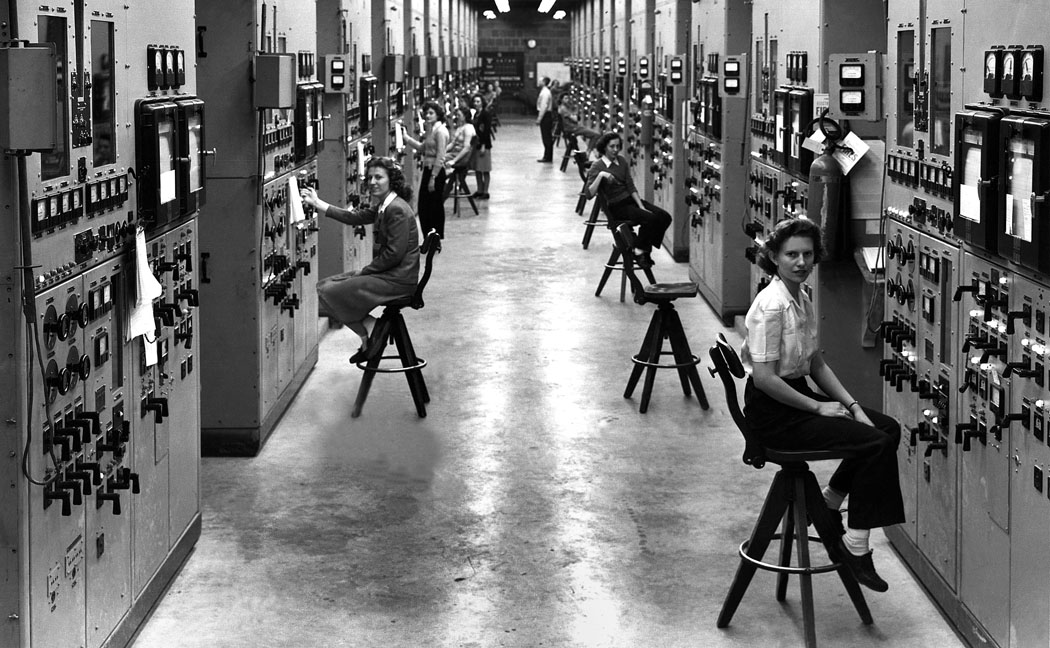
Calutron Girls
Working at the Y-12 uranium electromagnetic separation plant in Oak Ridge, Tennessee, women known as “Calutron Girls” played a critical role during the development of “Little Boy,” the first of two atomic bombs dropped on Japan to end World War II. Part of the Manhattan Project, thousands of young women, most only high school graduates, were recruited from all across the Southeast from 1943 to 1945 to fill numerous low-skilled positions at the U. S. Army’s Clinton Engineer Works, or Oak Ridge as it was later called, about thirty miles west of Knoxville in Anderson County.
One such position available to women was monitoring the mass spectrometers of Y-12’s 1152 Calutrons–electromagnetic devices used to separate uranium-235 from the more plentiful uranium-238 isotopes. Young women, such as Tennessee high school graduates Ruth Huddleston and Hazel Franklin, were chosen for this work in part because wartime labor shortages forced male workers at the complex into more labor-intensive jobs. In addition, the work required sitting for hours at a time — on seats without backs — constantly monitoring various meters and dials to keep levels consistent, functions that at the time were considered suitable for female workers.
The purpose of the work was so secret that the calutron monitors did not know all the details. Ruth Huddleston recalled, “I didn’t have any idea what we were doing. We weren’t allowed to even talk to anybody about what we were doing. All I know is they told us we were doing something to help win the war.”
The Tennessee Eastman Company recruited the calutron workers, one of many private companies contracted by the federal government to execute the Manhattan Project. East Tennessee women, who had few opportunities for employment other than at local textile mills for low wages, enthusiastically applied for jobs as “calutrons” at Oak Ridge because they earned higher pay, “helped the boys” overseas, and relished the independence that working away from home afforded them. Initially looked down upon by Manhattan Project experts across the U.S. as unqualified for the role due to their lack of education and experience, the girls at Oak Ridge proved themselves highly capable, even beating a team of the more academically qualified scientists at the project’s site at the University of California, Berkeley, in a challenge contest.
Ed Westcott, a government employee and the only photographer allowed to work on the site, documented the work performed by the calutron operators and their lives at Oak Ridge. Westcott, later a renowned photographer, not only captured the women at work but also shot images of them enjoying weekly dances and other leisure activities organized by official personnel at the Secret City.
Like other women at Oak Ridge, “cubicle operators” were unaware of the historic significance of their work and were sworn to silence about anything related to the project. According to some testimonies, girls who broke the latter rule often “disappeared” quickly, never to be seen again by those who remained. Like many other American citizens and soldiers during the war, they tended to perform their job duties as ordered without asking questions. Only when the atomic bombs they had helped create were used against Japan to end World War II did these women understand the full importance of their work.
Although relieved that the bomb they had helped create ended the war, many Calutron workers, like Huddleston, retained mixed feelings about their role due to the devastating loss life in Japan. “I found out the day after they bombed Japan that we had a part in it,” Huddleston later reflected. “We were producing uranium. I felt like I had a part in helping end the war, but I kept thinking I had a part in killing those people, that’s the part that bothered me. But then I knew that in war there’s killing, and I had to weigh that over and over in my mind to tell myself that and I accepted it. I still think about it.”



